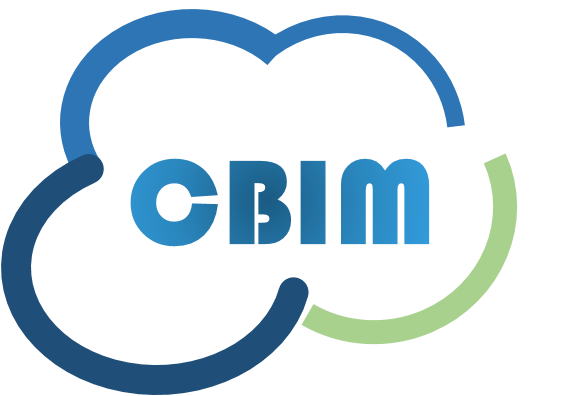




CBIM - European Training Network
Background
Digital Twins in the Built Environment
In manufacturing, digital twins are digital representations of physical products that store all relevant information over a product's life-cycle. Digital twins allow meaningful integration and structuring of data collected about products and leverage advanced sensing and analytics to provide real-time insights about a product’s status and performance. Digital twins may also provide input data to models so that the behaviour of a product at any stage in its life-cycle can be predicted. With these features, it is not surprising that many engineering products are now managed, and often operated, through their digital twins.
In the built environment, advanced sensing technologies and the Internet of Things (IoT), contribute to making buildings and infrastructure assets major sources of data. Like other domains, data can only be processed to yield insights only when relevant contextual information exists. Unlike other domains, with most of the building stock and infrastructure in Europe predating modern digital design, contextual information is missing or unusable. This makes the cost of generating, exploiting and sharing digital twins of buildings and infrastructure at a mass scale prohibitive.
Building Information Modelling
Building Information Modelling (BIM) can provide the context for representing infrastructure assets, including buildings, as digital twins. BIM involves the generation and management of digital representations of physical and functional characteristics of physical infrastructure assets, such as buildings, plants, roads, bridges, ports, tunnels, and utility networks. At present, BIM allows stakeholders to extract and exchange information for networked decision-making; individuals, businesses and government agencies can use BIM to plan, design, construct, and operate physical infrastructure for individual projects. Hence, BIM offers infrastructure owners the potential to compile digital twins bringing all types of data together and allowing their cross-platform exploitation by Architecture, Engineering, Construction and Facility Management (AEC/FM) stakeholders.
BIM usage to design, engineer, and deliver new facilities in the AEC/FM sector rose from 13% in 2010 to 74% in 2018, and its use is spreading inexorably. However, the way BIM is currently understood and used by AEC/FM sector professionals is entirely constrained by the narrow view imposed by local commercial imperatives and the extent of the current imagination. For most infrastructure owners and practitioners, BIM is still an information process and a set of technologies that can be used to optimise the design and delivery of individual construction projects. The idea that BIM models can be thoroughly verified through engineering analyses and operational performance simulations before construction, and thus provide the AEC/FM sector – which has never enjoyed the benefits of rigorous prototyping – with rich virtual counterparts, is starting to be talked about but barely understood. The notion of compiling multi-dimensional models that can support the entire asset lifecycle, and that such models can be mined for data and used for machine-learning, requires a leap of imagination.
BIM is still rapidly evolving both conceptually and in practice. Models are often proprietary and not widely available, design models are seldom updated during construction, interoperability problems are abundant, and only ~2% of the existing building stock has been designed with BIM. The slow pace of manual, incomplete and poor-quality digitisation can be accelerated and improved through the methods proposed here. This complex task requires an understanding of the multiple application requirements, overcoming the limitations of evolving BIM standards, and development of new technologies to generate, enrich and exploit models in the cloud.
What is CBIM?
CBIM is a European Training Network in the area of Cloud-based Building Information Modelling. CBIM brings together five leading universities, two software companies and a research institute from six countries, to provide PhD training through state-of-the-art research.
Building Information Modelling (BIM) as a product and process enables stakeholders across the built environment sector to create digital versions of real world assets (such as buildings, bridges and tunnels). The digital versions are commonly called ‘digital twins’. When placed on the cloud, the digital twins can serve as a resilient and integrated repository of all asset data throughout their life-cycle. Such a repository is a key enabler in this sector of all upcoming IT waves, such as cloud computing, data analytics, participatory sensing, and smart infrastructure.
The potential benefits have attracted interest from a wide array of end-users whose interests span from early design phases to operation and asset management, and from roads and bridges to industrial off-shore facilities. This has led to aggressive market penetration in the last decade. However, the full potential of BIM is currently exploited only in a fairly narrow range of applications. This is mainly due to the lack of trained scientific personnel capable of understanding the value of BIM and creating the link between digital twins and possible applications.
The ambition of CBIM is therefore to educate researchers in the development of a set of novel and disruptive BIM technologies that will automate the generation and enrichment of digital twins, improve the management, security and resilience of BIM-enabled processes, and boost the industrial uptake of BIM across sectors and disciplines by training these researchers to valorise and exploit their work. This new generation of researchers can play a key role in the widespread implementation of BIM products and processes dedicated to digitising our built infrastructure and managing our assets better to yield massive gains in sustainability, productivity and safety.
Goals
The "Cloud BIM" (CBIM) training network aims to set the foundations for generating and exploiting digital twins of existing assets. It will make a step change in addressing the practical barriers to the concept and train capable Early Stage Researchers (ESRs). Effective training of future experts in this interdisciplinary field is expected to alleviate technology transfer delays from academia to industry. The CBIM network will address these challenges by bringing together European partners with complementary world-leading expertise to form a long-term ‘best (of academia) with best (of industry)’ partnership, with three common objectives:
- To develop a joint research programme towards delivering the vision of the ‘Digital Twin’ for representing buildings and infrastructure. The significant research advances planned will overcome current knowledge and innovation gaps in the areas of generating, enriching, and updating Digital Twins of existing assets. The project will also set basic precedences of how to best exploit BIM-based digital twins for proces modelling and simulation through concepts and showcase applications that highlight opportunities for widespread use in managing the existing infrastructure and building stock.
- To offer original and advanced training to a group of Early Stage Researchers in all the multi-disciplinary aspects of CBIM such that, by the end of their training, these fellows can be directly embedded in the European AEC/FM sector and make immediate contributions. At the end of their training, they will have all necessary skills for capturing, enriching, and using digital twins to identify new application areas of CBIM and propose new CBIM products and processes to target those areas. A substantial part of the training programme will be dedicated to ESRs gaining experience in the non-academic sector, as well as to transferable skills training in developing business concepts and entrepreneurship, with the aim to encourage technology transfer and boost BIM deployment in the European construction sector.
- To demonstrate the societal benefits, and to bring industrial and societal acceptance of the capabilities of CBIM in infrastructure to optimise asset performance, to provide for the efficient use of resources, and to advance our understanding of complex problems in many engineering disciplines. In addition to the development and implementation of new CBIM generation, enrichment and application tools, this also requires dissemination to specialists and outreach to the wider public.
Why “Cloud BIM” in Europe?
Europe has the key advantage to host a full set of specialists who can make such an ambitious concept a reality. The CBIM consortium draws upon expertise distributed across Europe to form the full chain of experts that can create real-world demonstrations of CBIM’s potential and applications. The consortium gathers researchers in BIM standards, lifecycle data management, operation optimisation, data provenance and facility management, AEC/FM data fusion, and geometric learning and semantic enrichment together with BIM design, construction and operation software providers. This partnership merges the know-how and the complementary skills of stakeholders in academia, multinational companies and SMEs. All partners have significant experience in technology transfer and academic entrepreneurship. CBIM will hence contribute to obtaining a set of improved and novel CBIM products and associated processes with unprecedented capabilities for generating information-rich BIM models in the cloud, and it will bring these technologies to the European AEC/FM industry and end users.


This project has received funding from the European Union’s Horizon 2020 research and innovation program under the Marie Skłodowska-Curie grant agreement No 860555.
For more information see CBIM on CORDIS